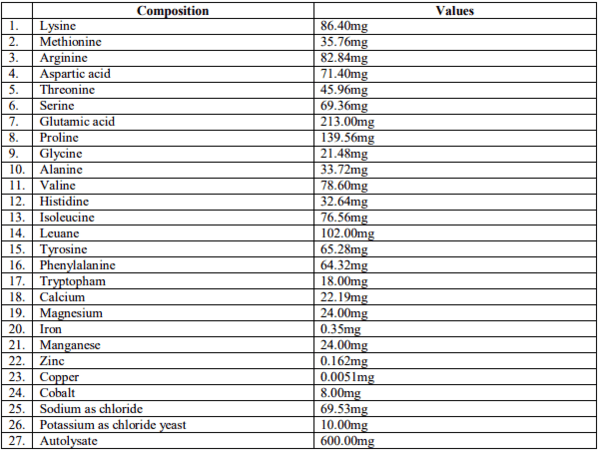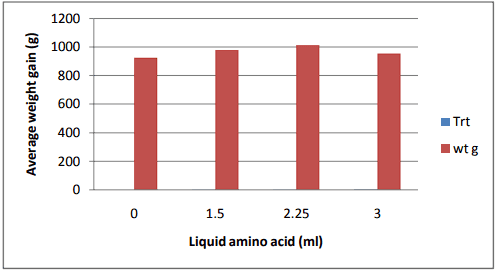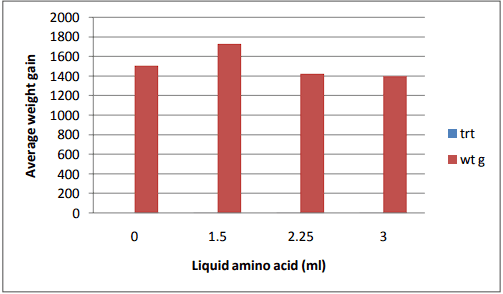INTRODUCTION
In practice it is very difficult, if not impossible; to formulate diets with natural feed ingredients that will provide all the amino acids needed by broiler chickens in adequate quantities. The optimal use of liquid and synthetic amino acids in animal diets, therefore, becomes important not only in nutrition and economic aspects, but also in environmental aspects. It is well known that optimal use synthetic amino acid improves amino acid balance and protein quality; as well they promote high lean meat production (NRC 1994). There is an ongoing discussion in the literature regarding the relative bio-efficacy of liquid amino acid relative to dry synthetic amino acid (Jansman et al, 2003). Recent work by Lemme et al. (2002), reported an average relative effectiveness of liquid DL-Met hydroxy analog-free acid (MHA-FA) compared with DLM of 62% based on weight gain, feed conversion, breast meat yield, and carcass yield in broiler chickens. Eurolysine proposes two kinds of liquid lysine, a low concentrated monohydrochloride ELL28 and a high concentrated lysine base LLB50 (Eudaimon, 1999). However, trials on broilers and pigs have shown that equivalent performances are obtained with liquid lysine base and crystalline L-Lysine (Eudaimon, 1999). Liquid amino acid supplementation in feed and water may give better performance during heat stress as birds tend to drink more water than consuming feed. It was also reported to be absorbed in the small intestine by the birds via the simple diffusion without the use of energy for transportation across the cell membrane (Eits et al, 2004; Elwert, et al, 2008). The outcome of this research will justify the use of liquid amino acid especially small scale poultry farmers who prefers to buy commercial feeds. In the tropics there is scanty information in the literature on the use of liquid amino acids for broilers, and some of the results are controversial. The objective of poultry farmers has long been to optimize growth at least cost and tissue accretion by increasing nutrient density. The question remains about the potential ways of increasing the nutrient density especially in broiler production. The use of synthetic and liquid amino acid in recent times has been suggested especially to farmer who cannot afford to formulate ration. This experiment therefore was conducted to evaluate the effectiveness of a selected liquid amino on performance of broiler chickens.
MATERIALS AND METHODS
The experiment was conducted using a total of 228 day-old Arbor Acre mixed sex broiler chicks. The initial heating was provided by 250- W infrared lamps, in order to maintain the temperature between 28 and 33 ºC during the first two weeks. The chicks were vaccinated against Marek’s disease and Gumboro disease in the hatchery, followed by vaccination at 5 and 21 days against Gumboro disease and on the 8th day against Newcastle disease. The litter was made from wood shavings and the amount placed in each pen was 1.3 kg of dry matter/bird housed, so that all treatments had the same initial amount of material used as litter at a height of 5 cm. The lighting schedule used was 21 hours of light throughout the experimental period. A commercial broiler starter and finisher diets were used for this study. The commercial broiler starter diet contained 3,000 kcal ME/kg and 23% CP while the finisher diet contained 2900, kcal ME/kg and 21.6% CP. Proximate analyses of these diets were similar to the manufacturer’s values for ME and CP. During the entire experimental period, the birds received feed and water ad libitum. During the initial period (1-28 days old), the birds were reared in floor pen. A commercial diet ( without liquid amino acid was used as the control (Treatment 1) while a liquid amino acid supplementation at 1.50mls, 2.25mls and 3.0mls /day in water represents treatment 2, 3 and 4 respectively. The liquid amino Acid (Proline) used was purchased from animal care company. At the end of the 28th day of age, the broilers were weighed, selected according to the criterion of average weight of each pen (1000±35 grams) and distributed in a completely randomized design involving four treatments with three replications of 19birds each containing varying levels of liquid amino acid at 1.50mls, 2.25mls and 3.0mls /day in water (Treatment 2, 3 and 4), respectively. The final body weight and feed intake were measured weekly. From the primary data collected for feed intake and weight gain, data for feed conversion ratio was generated. Mortality was recorded as it occurred.
Data Analysis
All data obtained were statistically analyzed using the General Linear Models (GLM) procedure of SAS (2001) for the analysis of variance. Duncan’s multiple range tests were used to determine differences among treatment means. Means were considered different at P< 0.05.
General Linear Model
Yij = µ + Ki + eij
Yij= Observation of the ith level of liquid amino acid as shown by broilers performance
µ= Overall mean
Ki =ith effect of tryptophan
eij = Random error
RESULTS AND DISCUSSION
The performance of broiler starter chickens given varied levels of liquid amino acid in drinking water indicated positive responses. It was observed that dietary treatments had significant effects (P< 0.05) on the final weight, weight gain and average daily weight gain for broiler starter chickens (Table 2). Total feed intake, feed conversion ratio, feed cost per kg gain and mortality were not (P> 0.05) significantly affected by levels of liquid amino acid supplementation. Variability in terms of performance was low though chicks fed control diet had poorer performance compared to chicks fed higher inclusion levels. The best performance in terms of the final weight, weight gain and average daily weight gain was already attained at 2.25ml (Figure 1). This result disagreed with the findings of Cardirci, (2012) and Hoehler et al, (2005), who reported that liquid amino acid in water is as good as when supplied wholly from the feed. This result also disagreed with the recommended value of 15ml/100birds which is equivalent to 2.85ml/19birds by the manufacturer. The variation in the result may be due to the genotype, availability of nutrients in the commercial diet and season of rearing. Table 3 shows the performance of broiler finisher chickens given water supplemented with varying level of liquid amino acid. It was observed that dietary treatments had significant (P< 0.05) effects on final weight, weight gain, average daily weight gain, feed conversion ratio and feed cost per kg gain. This result disagreed with the findings of Ribeiro et al. (2001) and Ribeiro et al. (2006). Who reported no significant differences for most performance parameters measured between chickens administered liquid amino and that given synthetic amino acid. Chickens given 1.50ml/day liquid amino acid in water had the best performance in terms of weight gain, feed conversion ration and feed cost per kg gain (Figure 2). This value (1.50ml/19birds/day) disagreed with the value suggested by the manufacturer (30ml/100birds = 5.7ml/19birds). This variation might be due to the fact that broiler finisher might not really need over supply of amino acid as the feed conversion efficiency at this phase might be slower compared to the chick phase, other reasons might be due to the genotype of the chickens and antagonistic reactions amongst individual dietary amino acids. Mortality was not influenced by the concentration of liquid amino acid over the whole experimental period.
Table 1. Liquid Amino Acid Constituents
Table 2. Performance of Broiler Chicks with varying Levels of Liquid Amino Acid (0- 4 Weeks)
a, b, = Means with different superscript on the same row differ significantly (P< 0.05). SEM = Standard Error of Means. FCR = Feed conversion ratio
Table 3: Performance of Broiler Chicks with varying Levels of Liquid Amino Acid (5- 8 Weeks)
a, b, = Means with different superscript on the same row differ significantly (P< 0.05). SEM = Standard Error of Means. FCR = Feed conversion ratio
Figure 1. Effect of liquid amino acid on weight gain of broiler starter chicks (0-4 weeks).
Figure 2. Effect of Liquid amino acid on weight gain of broiler finisher chickens (5-8 weeks).
CONCLUSION
The study showed that growth performance of broilers chickens can be enhanced by supplementing liquid amino acid in water. The results indicated that inclusion of liquid amino acid in drinking water at 2.25ml/19birds/day for the starter phase and 1.50ml/19birds/day for the finisher phase had better performances in terms of feed conversion ratio, more profit and reduced production cost. Although the optimum liquid amino acid values obtained both for the starter and finisher phases were far lower, compared to the manufacturer’s recommendation, this significantly lowered the cost of production.
This article was originally published in International Journal of Research in Agriculture and Forestry Volume 4, Issue 7, 2017, PP 37-41.


















